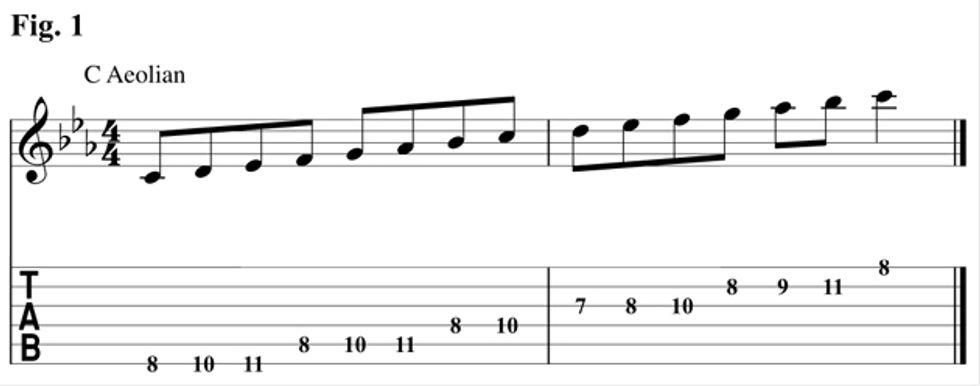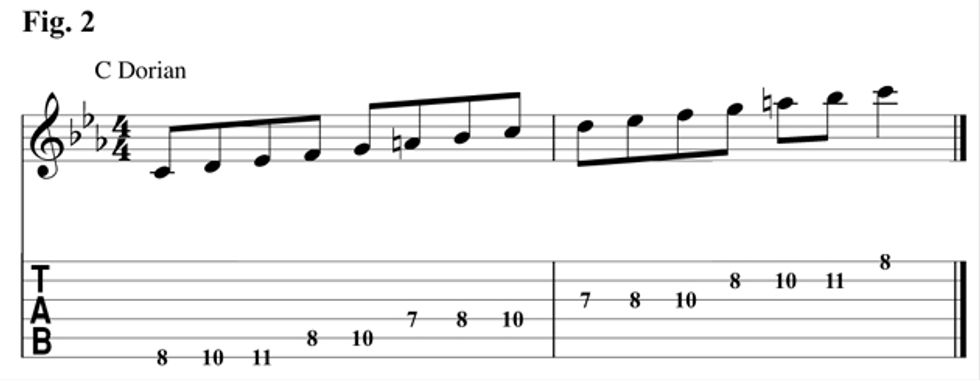Understand the subtle differences between the Dorian and Aeolian modes, and learn new licks that exploit all these modes have to offer.
Chops: Intermediate
Theory: Intermediate
Lesson Overview:
• Understand the difference between the Dorian and Aeolian modes.
• Create modal vamps to better internalize the sound of these scales.
• Target specific notes within a scale to generate musical effects.
Click here to download a printable PDF of this lesson's notation.
In our previous lesson, we toyed with some variations on the minor blues progression, and hopefully you can now hear the difference between them. Now let's use the minor 7 chord as a tool to help us understand the much-hyped subject of modes.
As I'm sure many guitarists will agree, understanding modes can be a nightmare. The reason for this is that you can tackle modes from two totally different angles. In my experience, the angle most often taken by people learning and teaching on YouTube is the easy way, and when it comes to learning, we all know that shortcuts are only going to leave holes. Let me start by describing a mode the way a classical theory teacher might explain it. If you play the white keys on the piano, you have the notes C-D-E-F-G-A-B, commonly referred to as the C major scale. When we play through these notes starting on the second tone, we get D-E-F-G-A-B-C. The notes are the same, but we're treating D as the root. We're taught to call this the Dorian mode.When we do this starting on each note of the C major scale, we get the following:
- C to C – Ionian
- D to D – Dorian
- E to E – Phrygian
- F to F – Lydian
- G to G – Mixolydian
- A to A – Aeolian
- B to B – Locrian
Musicians all over the world learn to think of modes this way. Then at a jam night when someone says, “Hey, let's jam in E Lydian,” these players go through a strange, convoluted decoding process:
“Okay, don't panic. Lydian is based on the fourth degree of the major scale. So E Lydian has the same notes as ... (counts down frets on the guitar) B major. So if I want to play E Lydian, I need to play a B major scale. But I have to remember to use E as the root.”
Sounds silly when you read that on a page, right?
This method is sometimes called “derivative” because you're taking your mode from the parent key and you never really understand the difference between the modes—just how to find the right notes.
By contrast, the method I encourage you to learn is often called “parallel.” With this approach, we compare all the modes to each other using the same root note.
If we take a step back to our dominant 7 chord lessons, you'll remember how much we used the Mixolydian mode, so let's quickly look at this scale from both approaches, starting with the derivative method
G Mixolydian contains the same notes as C major:
G–A–B–C–D–E–F–G
C–D–E–F–G–A–B–C
Just take a look at those two sets of notes and ask yourself: Do you understand the Mixolydian mode now? Of course you don't, that's just confusing. So let's try parallel:
G–A–B–C–D–E–F#–G
G–A–B–C–D–E–F–G
Right—now you can clearly see that the Mixolydian scale is a major scale with a lowered 7 (b7).
In this lesson we'll explore the relationship between the Dorian and Aeolian modes. Both work over minor 7 chords, but yield dramatically different sounds. We can use both of these sounds when playing over a minor blues and both will convey different feelings.
First, let's compare C Aeolian to C Dorian and go from there:
C Aeolian C–D–Eb–F–G–Ab–Bb (R–2–b3–4–5–b6–b7)
C Dorian C–D–Eb–F–G–A–Bb (R–2–b3–4–5–6–b7)
In Fig. 1 and Fig. 2 you can see (and hear) a simple fingering for each scale. As you play up the scale, see if you can predict what each note will sound like. Pay close attention to the 6th degree, which is the only difference between the two modes.
I believe the best way to learn modes is to play chord vamps that capture the true sound of the mode. Each mode has a sound and when you think of the mode you need to think of the sound that it creates when used, so here are two modal vamps that outline these two modes. Fig. 3 is an Aeolian vamp and Fig. 4 is based in Dorian.
Did you notice how different the two modes sound? (If that sparked interest it may be worth checking out Frank Gambale's DVD, Modes: No More Mystery.) Now let's check out some licks from each mode to hear the moods they create.
Our first lick (Fig. 5) starts by highlighting the b6, and right off the bat I've hit you with the defining note before finishing up with some more traditional minor pentatonic phrasing.
The second lick (Fig. 6) teases the b6 a few times, first in a repeating motif in the first measure, then again in the second measure. What you notice in the second measure is that the b6 pulls very strongly down to the 5. I wouldn't consider it a note you can sit on for long, yet it has a powerful sense of sadness when used properly.
Our final Aeolian lick (Fig. 7) has a bit more range, starting with some standard blues-rock phrasing, then sliding up to the b6, bending to the b7, restating the b6, and coming to rest on the 5. I find this especially expressive in a ballad context.
For the Dorian phrases, the main difference is that the 6 is quite a hip note to sustain over a minor chord because it implies a minor 6 sound. You'll notice that the final note in Fig. 8 has us sitting on that 6.
The next lick (Fig. 9) starts with a more traditional blues sound, but then comes to rest on the 6. You can even experiment with the minor 6 pentatonic scale (a favorite of Robben Ford), which consists of R–b3–4–5–6. You can think of it as a minor pentatonic scale with a 6 replacing the b7.
Our final lick (Fig. 10) offers a bit more range, starting out in the 1st-position minor pentatonic shape before moving to the 4th position. Notice how we target the 6 before resolving on the root.
Jam a bit over the provided backing track below—it has a C minor tonality—and see which sound you find yourself more at home with. With experimentation you'll hear how each mode captures a completely different feeling, yet both provide potent ways to express yourself.
Next time we'll apply these modes to a full minor blues progression to see how we can create something musical out of all this theory.












